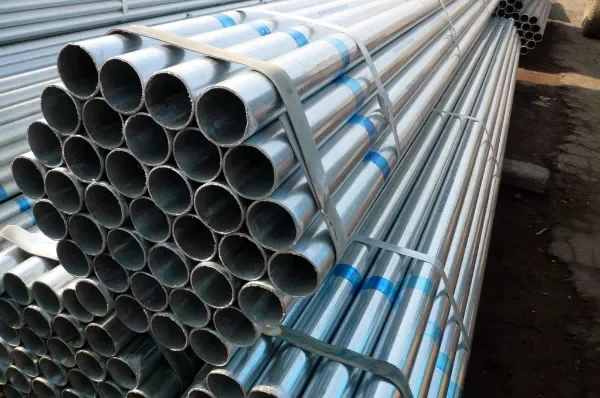Advantages and process of hot-dip galvanized steel pipe
With the development of industry, hot-dip galvanized products have been used in many fields. The advantage of hot-dip galvanizing is that it has a long anti-corrosion life and is a popular anti-corrosion treatment that can be adapted to a wide range of environments. It is widely used in electric power pylons, communication pylons, railroads, highway protection, street light poles, marine components, building steel structure components, substation appurtenances, light industry, etc. Hot-dip galvanizing has a long anti-corrosion life, but the anti-corrosion life varies in different environments: 13 years in heavy industrial areas, 50 years in the ocean, 104 years in the suburbs, and 30 years in cities.
Principle of hot-dip galvanized steel pipe: The iron parts are cleaned, then solvent treated, dried and immersed in a zinc solution, where the iron reacts with the molten zinc to produce an alloyed zinc layer. The process is: degreasing - washing - pickling - assisted plating - drying - hot dip galvanizing - separation - cooling passivation.
The thickness of the alloyed layer of hot-dip galvanizing depends mainly on the chemical composition of the steel such as silicon content, the size of the cross-sectional area of the steel, the roughness of the steel surface, the temperature of the zinc pot, the time of zinc dipping, the speed of cooling, the cold rolling deformation, etc.
Advantages of hot-dip galvanized steel pipes
Low treatment cost:The cost of hot-dip galvanizing for rust prevention is lower than that of other paint coatings.
Durability: In suburban environments, the standard hot-dip galvanized rust protection layer can be maintained for more than 50 years without repair; in urban or offshore areas, the standard hot-dip galvanized rust protection layer can be maintained for 20 years without repair.
Reliability: The galvanized layer is metallurgically bonded to the steel and becomes part of the steel surface, so the coating is more reliable and long-lasting.
Toughness of the coating: The galvanized layer forms a special metallurgical structure that can withstand mechanical damage during transportation and use.
Comprehensive protection: Every part of the plated part is coated with zinc, even in recesses, sharp corners and hidden areas.
Time and labor saving: The galvanizing process is faster than other coating methods and avoids the time required to paint on site after installation.
Low initial cost: In general, the cost of hot-dip galvanizing is lower than applying other protective coatings, simply because other protective coatings such as sanding and painting are labor-intensive, whereas hot-dip galvanizing is a highly mechanized, closely controlled, in-plant process.
Inspection is simple and easy: Hot-dip galvanizing can be tested visually and with a simple, non-destructive coating thickness gauge.
Reliability: Hot-dip galvanizing is generally specified in accordance with BS EN ISO 1461, which specifies a minimum thickness of zinc, so its rust resistance and performance is reliable and predictable.
Current status of the hot-dip galvanized pipe process
To produce zinc alloy, a zinc smelter simply adds a medium-frequency coreless induction furnace to prepare the intermediate alloy. The original high-power induction furnace used for melting zinc flakes is modified by opening a hole in the center of the furnace roof, adding a stirring device, metering the intermediate alloy, stirring and mixing, and casting.
This mode of production is characterized by a simple process and easy transformation of the existing ingot melting furnace, which is widely used by zinc smelters:
According to the heating characteristics of the cored induction furnace, it is necessary to have a starting melt furnace to work. That is, the minimum height of the metal level in the furnace must ensure that the induction trench of the induction body can be submerged. Therefore, each time a zinc alloy is prepared, only about 1/3 of it can be poured (i.e., the remaining metal level is guaranteed to be above the starting melt height), and then zinc flakes must be added to the melt and re-prepared for the next intermittent melt. When alloy preparation, stirring and pre-furnace analysis can only stop heating or holding, the advantages of continuous melting in high-powered induction furnaces are not played out, and the stirrer's lifting out and lifting in is troublesome to operate.
As the diameter of the stirring blade is restricted by the diameter of the aperture opened on the top (affecting the thermal efficiency), the impact of small-scale stirring on the rectangular furnace chamber is limited, so the inadequate stirring and the iron increase effect of the blade, the uniformity of the composition and and the iron content requirements are brought negative impact.
When the alloy species needs to be changed, the furnace washing of large capacity cored induction furnaces is a time-consuming and troublesome task, and when changing the alloying elements, the furnace washing requires a long period of continuous operation to complete.
When releasing the alloy liquid to add a large amount of zinc flakes, the temperature is the lowest and requires high power to raise the temperature; when dispensing intermediate alloys, the temperature needs to rise to the highest, which is not conducive to control in terms of energy consumption and metal burnout.







